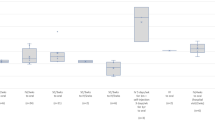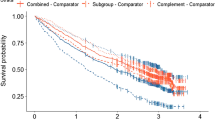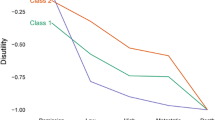Abstract
Background
The increased use of patient preference data in healthcare decision making has raised concerns about the reliability and consistency of the estimates generated by patient preference studies. However, literature reviews to assess the consistency of preferences are confounded by heterogeneity in study designs.
Methods
This paper adopted a novel approach to evaluating preference consistency: comparing estimates of a single trade-off—the marginal rate of substitution (MRS) between survival improvements and risks of adverse events—across multiple patient groups and using meta-regression to assess whether MRS varied systematically between patients. A log-linear, random effects regression was run, weighted for the sample sizes of studies from which estimates were extracted.
Results
Using studies identified in published reviews of patient preference data, 42 estimates of MRS were generated from the 12 studies. On average, patients obtained the same utility from a 2.3% reduction in the risk of an adverse event as from a 1-month increase in survival, with a range of 0.002–13.5%. The regression model had an R2 of over 90% and suggests that MRS depended on patients’ expected survival and the type of adverse event being traded.
Conclusion
These results suggest that although preferences vary between patients, they may do so in systematic and predictable ways. Further, they do so in ways consistent with societal preferences and decision maker priorities toward end-of-life settings. Further work is required to replicate this result in other patient groups and to explore the consistency of preferences for other treatment attributes.

Similar content being viewed by others
References
Egbrink MO, IJzerman M. The value of quantitative patient preferences in regulatory benefit-risk assessment. J Market Access Health Policy. 2014;2(1):22761.
van Til JA, Ijzerman MJ. Why should regulators consider using patient preferences in benefit-risk assessment? New York: Springer; 2014.
US Food and Drug Administration. Factors to Consider When Making Benefit-Risk Determinations in Medical Device Premarket Approval and De Novo Classifications: Guidance for Industry and Food and Drug Administration Staf. 2019. https://www.fda.gov/media/99769/download. Accessed 10 Nov 2020.
US Food and Drug Administration. Patient Preference Information—Voluntary Submission, Review in Premarket Approval Applications, Humanitarian Device Exemption Applications, and De Novo Requests, and Inclusion in Decision Summaries and Device Labeling: Guidance for Industry, Food and Drug Administration Staff, and Other Stakeholders. In: US Food and Drug Administration. 2020.
European Medicines Agency (EMA). EMA Regulatory Science to 2025: Strategic reflection. 2020. https://www.ema.europa.eu/en/documents/regulatory-procedural-guideline/ema-regulatory-science-2025-strategic-reflection_en.pdf.
Innovative Medicines Initiative (IMI). The Patient Preferences in Benefit-Risk Assessments during the Drug Life Cycle (PREFER). 2018. https://www.imi-prefer.eu/. Accessed 5 May 2018.
Marsh K, van Til JA, Molsen-David E, et al. Health preference research in Europe: a review of its use in marketing authorization, reimbursement, and pricing decisions-report of the ISPOR stated preference research special interest group. Value Health. 2020;23(7):831–41.
Guidelines AGDoHTPBAC. Appendix 6 Including nonhealth outcomes in a supplementary analysis. 2016. https://pbac.pbs.gov.au/appendixes/appendix-6-including-nonhealth-outcomes-in-a-supplementary-analysis.html. Accessed 10 Nov 2020 10.
Bouvy JC, Cowie L, Lovett R, Morrison D, Livingstone H, Crabb N. Use of patient preference studies in HTA decision making: a NICE perspective. Patient-Patient-Centered Outcomes Res. 2020;13(2):145–9.
van Overbeeke E, Forrester V, Simoens S, Huys I. Use of patient preferences in health technology assessment: perspectives of canadian, belgian and German HTA representatives. Patient-Patient-Centered Outcomes Res. 2020:1–10.
van Overbeeke E, Janssens R, Whichello C, Bywall KS, Sharpe J, Nikolenko N, et al. Design, conduct and use of patient preference studies in the medical product life cycle: a multi-method study. Front Pharmacol. 2019;10:1395.
Huls SP, Whichello CL, van Exel J, Uyl-de Groot CA, de Bekker-Grob EW. What is next for patient preferences in health technology assessment? a systematic review of the challenges. Value Health. 2019;22(11):1318–28.
Janssens R, Huys I, van Overbeeke E, Whichello C, Harding S, Kübler J, et al. Opportunities and challenges for the inclusion of patient preferences in the medical product life cycle: a systematic review. BMC Med Inform Decis Mak. 2019;19(1):189.
Vass CM, Wright S, Burton M, Payne K. Scale heterogeneity in healthcare discrete choice experiments: a primer. Patient-Patient-Centered Outcomes Res. 2018;11(2):167–73.
Carson RT, Louviere JJ, Rose JM, Swait J. Frontiers in modeling discrete choice experiments: a benefit transfer perspective Benefit transfer of environmental and resource values. New York: Springer; 2015. p. 209–36.
Johnston RJ, Rolfe J, Rosenberger RS, Brouwer R. Benefit transfer of environmental and resource values. The economics of non-market goods and resources. New York: Springer; 2015.
Kevin Marsh, editor. IP13: Can patient preference information be generated for multiple uses across different treatment comparisons and associated decisions? Virtual International Society for Pharmacoeconomics and Outcomes 2020; 2020.
Yu T, Enkh-Amgalan N, Zorigt G. Methods to perform systematic reviews of patient preferences: a literature survey. BMC Med Res Methodol. 2017;17(1):166. https://doi.org/10.1186/s12874-017-0448-8.
Gonzalez JM. Evaluating risk tolerance from a systematic review of preferences: the case of patients with psoriasis. Patient. 2018;11(3):285–300. https://doi.org/10.1007/s40271-017-0295-z.
Quaife M, Terris-Prestholt F, Di Tanna GL, Vickerman P. How well do discrete choice experiments predict health choices? a systematic review and meta-analysis of external validity. Eur J Health Econ. 2018;19(8):1053–66.
Watson V, Becker F, de Bekker-Grob E. Discrete choice experiment response rates: a meta-analysis. Health Econ. 2017;26(6):810–7.
de Ayala A, Mariel P, Meyerhoff J. Transferring landscape values using discrete choice experiments: is meta-analysis an option? Agric Resour Econ. 2014;14(1):1–16.
Soekhai V, de Bekker-Grob EW, Ellis AR, Vass CM. Discrete choice experiments in health economics: past, present and future. Pharmacoeconomics. 2019;37(2):201–26.
Duenas A, Yuan Z, Levitan B, Tervonen T. Reporting and quality of patient preference studies: a systematic literature review in the cardiovascular domain. ISPOR; Copenhagen Copenhagen, Denmark.
Barraclough H, Simms L, Govindan R. Biostatistics primer: what a clinician ought to know: hazard ratios. J Thorac Oncol. 2011;6(6):978–82.
NCSS. NCSS Statistical Software: Survival Parameter Conversion Tool. https://ncss-wpengine.netdna-ssl.com/wp-content/themes/ncss/pdf/Procedures/NCSS/Survival_Parameter_Conversion_Tool.pdf. Accessed 18 Feb 2021.
Office for National Statistics. National life tables: UK. https://www.ons.gov.uk/peoplepopulationandcommunity/birthsdeathsandmarriages/lifeexpectancies/datasets/nationallifetablesunitedkingdomreferencetables.
Shah KK. Severity of illness and priority setting in healthcare: a review of the literature. Health Policy. 2009;93(2–3):77–84.
Zorginstituut Nederland. Cost-effectiveness in practice. In: Zorginstituut Nederland. 2015.
Author information
Authors and Affiliations
Corresponding author
Ethics declarations
Funding
The study received no financial support.
Conflict of interest
Kevin Marsh and Nicolas Krucien have no conflicts of interest that are directly relevant to the content of this article.
Availability of data and material
The datasets generated and/or analysed during the current study are available from the corresponding author on reasonable request.
Code availability
Not applicable.
Author Contributions
Kevin Marsh conceptualised the manuscript and led the review. Nicolas Krucien conducted the analysis. Both authors were involved in the writing of the manuscript.
Ethics approval
Not applicable.
Consent to participate
Not applicable.
Consent for publication
Not applicable.
Acknowledgements
The authors acknowledge Myrto Trapali for support identifying preference studies included in the review.
Supplementary Information
Below is the link to the electronic supplementary material.
Rights and permissions
About this article
Cite this article
Marsh, K., Krucien, N. Evaluating the Consistency of Patient Preference Estimates: Systematic Variation in Survival—Adverse Event Trade-Offs in Patients with Cancer or Cardiovascular Disease. Patient 15, 69–75 (2022). https://doi.org/10.1007/s40271-021-00513-3
Accepted:
Published:
Issue Date:
DOI: https://doi.org/10.1007/s40271-021-00513-3




